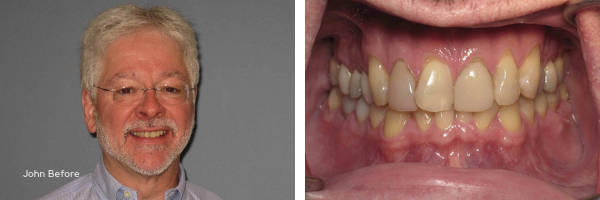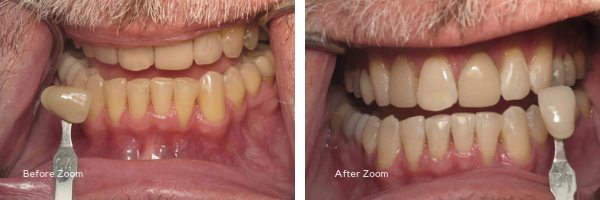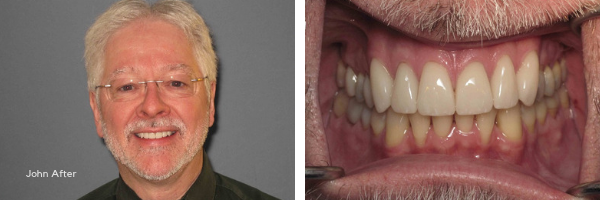By: Dr. Elizabeth Eggert
How did this start?
John had existing restorations on some of his upper front teeth which were done several years prior and were beginning to break down and decay. John wanted to preserve the function of his teeth and was also interested in improving their appearance. Dr. Elizabeth recommended he go through the Records Process to determine the best way to restore his teeth.

What is the Records Process?
The Records Process consists of two appointments. At John’s first appointment, Dr. Elizabeth took x-rays and photos of his teeth and did a comprehensive muscle and joint evaluation. She also took impressions of his teeth that she used to make models of his mouth. Over the next couple of weeks, Dr. Elizabeth used these models in conjunction with the information collected at his Records Appointment to analyze the current condition of John’s teeth and develop a treatment plan for him. She then put all of this information into a PowerPoint presentation that she reviewed with John when he returned for the second appointment, his case presentation.
What was revealed during the Records Process?
The details of the Records Process revealed that the current position of John’s teeth was putting them at high risk for continued wear. Dr. Elizabeth told John that if she replaced his veneer on his upper front tooth without addressing his bite and the position of his teeth, it was likely to eventually break or begin to decay again, and his other teeth would be more susceptible to wear. John also indicated that he frequently had muscle pain in his neck and after listening to all the connections Dr. Elizabeth made at his case presentation, he wondered if it might be related to clenching his teeth.
What did Dr. Elizabeth recommend?
Dr. Elizabeth recommended starting with splint therapy so that John’s jaw muscles would be more relaxed and stable for eventual tooth movement. Dr. Elizabeth suggested he use an anterior deprogrammer, a small appliance worn on the upper front teeth to prevent the back teeth from touching and clenching together. After using the anterior deprogrammer for six months and undergoing some physical therapy for whole body alignment, John stopped clenching almost completely and noticed a significant improvement in his muscle pain. Dr. Elizabeth determined that he was ready to move forward with orthodontics.
Dr. Elizabeth recommended orthodontics for John to move his teeth into the ideal position before restoring them and set them up for less wear over time. Dr. Elizabeth thought John would be a good candidate for Invisalign, and John elected to do that instead of traditional braces. He completed his Invisalign treatment, after wearing a total of 42 aligners, in about one year.
Next, Dr. Elizabeth recommended the Zoom! whitening in-office bleaching procedure to get John the whiter smile he wanted. After his two-hour session, John was happy to see that his teeth had lightened by three full shades.

With his teeth being his desired shade, John was ready for his final restorations. John wanted his upper front teeth to be uniform in shape and size. For this reason, he decided to do veneers on all of his upper front teeth. Dr. Elizabeth worked with a local lab to create a wax model of the veneers so John could make sure he was happy with their size and shape before having the final restorations fabricated. John went through the veneer procedures and in a short time, had his final smile.
What does John think of his new smile?
From the beginning, John was very excited about his treatment and the prospect of improving not only the function and appearance of his teeth, but also his overall health. John had been experiencing neck and hip pain for about a year before undergoing the records process and is thrilled that the combination of splint therapy and physical therapy has resolved his issues. He loves the appearance of his smile with his new veneers and he’s happy knowing that they will function properly and because he opted for the most comprehensive treatment, he will have the most long-term predictability.
When asked what he would say to someone considering similar treatment, John said “Do it! Your teeth are important and the associated effects are important too”.
